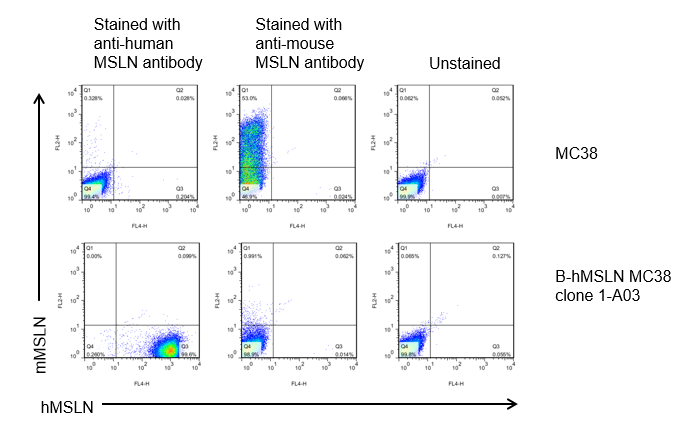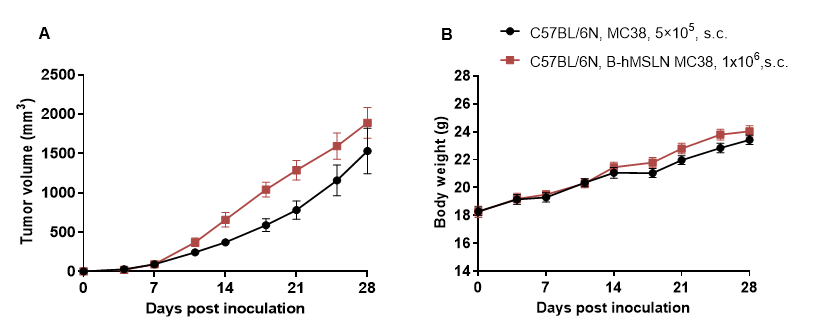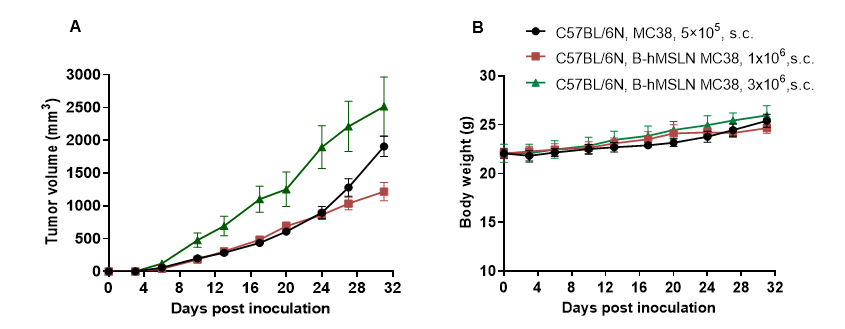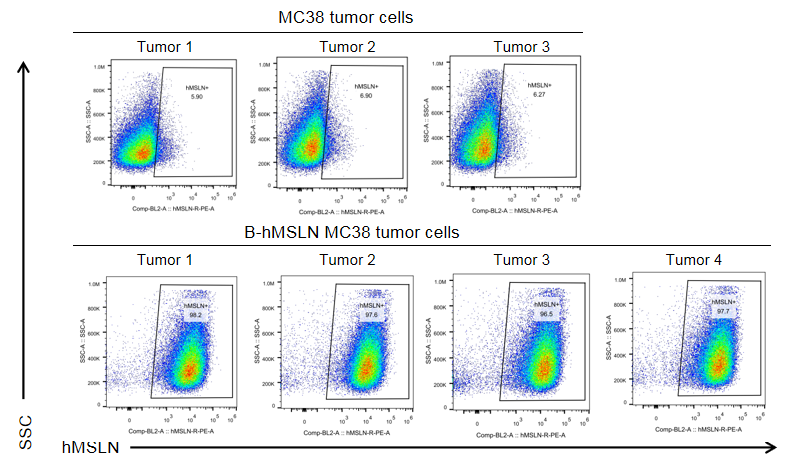|
Common name |
B-MSLN MC38 | Catalog number | 332181 |
| Aliases |
MPF,SMRP |
Disease | Colon carcinoma |
|
Organism |
Mouse |
Strain | C57BL/6 |
| Tissue types | Colon | Tissue | Colon |
Targeting strategy

Gene targeting strategy for B-hMSLN MC38 cells. The exogenous promoter and full coding sequences of human MSLN was inserted to mouse exon 2 in B-hMSLN MC38 cells.
Protein expression analysis

MSLN expression analysis in B-hMSLN MC38 cells by flow cytometry. Single cell suspensions from B-hMSLN MC38 cultures were stained with species-specific anti-MSLN antibodies. Human MSLN were detected on the surface of B-hMSLN MC38 cells, mouse MSLN were not expressed anymore. The 1-A03 clone of B-hMSLN MC38 cells was used for in vivo experiments.
Tumor growth curve & Body weight changes

Subcutaneous homograft tumor growth of B-hMSLN MC38 cells. B-hMSLN MC38 cells (1x106) and wild-type MC38 cells (5x105) were subcutaneously implanted into C57BL/6 mice (female, 6-week-old, n=8). Tumor volume and body weight were measured twice a week. (A) Average tumor volume ± SEM. (B) Body weight (Mean± SEM). Volume was expressed in mm3 using the formula: V=0.5 × long diameter × short diameter2. As shown in panel A, B-hMSLN MC38 cells were able to establish tumors in vivo and can be used for efficacy studies.
Tumor growth curve of individual mice

Subcutaneous homograft tumor growth of B-hMSLN MC38 cells. B-hMSLN MC38 cells (1-A03) and wild-type MC38 cells were subcutaneously implanted into C57BL/6N mice (female, 6-week-old, n=8). As shown in panel, B-hMSLN MC38 cells were able to establish tumors in vivo and can be used for efficacy studies.

Subcutaneous homograft tumor growth of B-hMSLN MC38 cells. B-hMSLN MC38 cells (1x106) and wild-type MC38 cells (5x105) were subcutaneously implanted into C57BL/6 mice (female, 14-week-old, n=6). Tumor volume and body weight were measured twice a week. (A) Average tumor volume ± SEM. (B) Body weight (Mean± SEM). Volume was expressed in mm3 using the formula: V=0.5 × long diameter × short diameter2. As shown in panel A, B-hMSLN MC38 cells were able to establish tumors in vivo and can be used for efficacy studies.

Subcutaneous homograft tumor growth of B-hMSLN MC38 cells. B-hMSLN MC38 cells (1-A03) and wild-type MC38 cells were subcutaneously implanted into C57BL/6N mice (female, 14-week-old, n=6). As shown in panel, B-hMSLN MC38 cells were able to establish tumors in vivo and can be used for efficacy studies.
Protein expression analysis of tumor cells

Tumor cells were assessed for human MSLN expression by flow cytometry. As shown, human MSLN was expressed on the surface of tumor cells. Therefore, B-hMSLN MC38 cells can be used for in vivo efficacy studies of novel MSLN therapeutics.
B-hMSLN MC38 cells were subcutaneously transplanted into C57BL/6N mice (n=6), and on 34 days post inoculation, tumor cells were harvested and assessed for human MSLN expression by flow cytometry. As shown, human MSLN was expressed on the surface of tumor cells but very low. Therefore, B-hMSLN MC38 cells can be used for in vivo efficacy studies of novel MSLN therapeutics.







